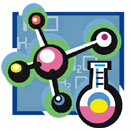ATOM MOLECULE LESSON PLAN MATTER PHYSICS CHEMISTRY
SCIENCE KID PRIMARY TEACHING LEARNING STUDENTS ELEMENTARY EDUCATION CURRICULUM
KIDS THEME UNIT RESOURCES ACTIVITY

 A science lesson
on atoms and molecules.. A science lesson
on atoms and molecules.. |
|
| |
 |
SCIENCE MATTERS:
ATOMS AND MOLECULES
An elementary
science
teaching lesson on atoms and molecules. Includes
printable teaching lesson worksheet.
Learning Objectives:
- Students will learn that matter is made of atoms.
- Students will learn that an atom is made of protons, neutrons and electrons, the charge of each particle, and how they are arranged to make up an atom.
- Students will learn the definition of a molecule, an element and a compound and will be able to point out the differences between the three.
- Students will learn that a chemical bond happens when two atoms share electrons.
- Students will be introduced to the Periodic Table of the Elements.
Grades
4th Grade - 5th Grade -
6th Grade
 |
 |
|
 |
|
|




|
|
|
 |
 |

 
|
ATOMS AND
MOLECULES
LESSON PLAN
Materials:
Classroom Activity:
Exploring the Periodic Table of the Elements
- Using the Periodic Table, show students that each element has a name, a symbol (a two letter abbreviation), and an atomic number.
- Show them how they can use the Periodic Table to learn about what phase of matter, solid, liquid, or gas, the element is most commonly found.
- Discuss how the Periodic Table arranges the elements in order from smallest to largest. Hydrogen has only one proton and one electron and is the lightest element—and so it has an atomic number of one. Sulfur, has 16 protons, and an atomic number of 16. Mercury, has 80 protons, and has an atomic number of 80.
- Ensure that the students understand the relationship between the atomic number of each element and the number of protons in that element (they are the same).
More Science
Lesson Plans, Teaching Worksheets, Lessons
 For more
teaching material, lesson plans,
lessons, and worksheets please go back to the InstructorWeb home page. For more
teaching material, lesson plans,
lessons, and worksheets please go back to the InstructorWeb home page.
|
|
|
|
| |
|
 |
© 2002-2006 InstructorWeb
 |
|
|